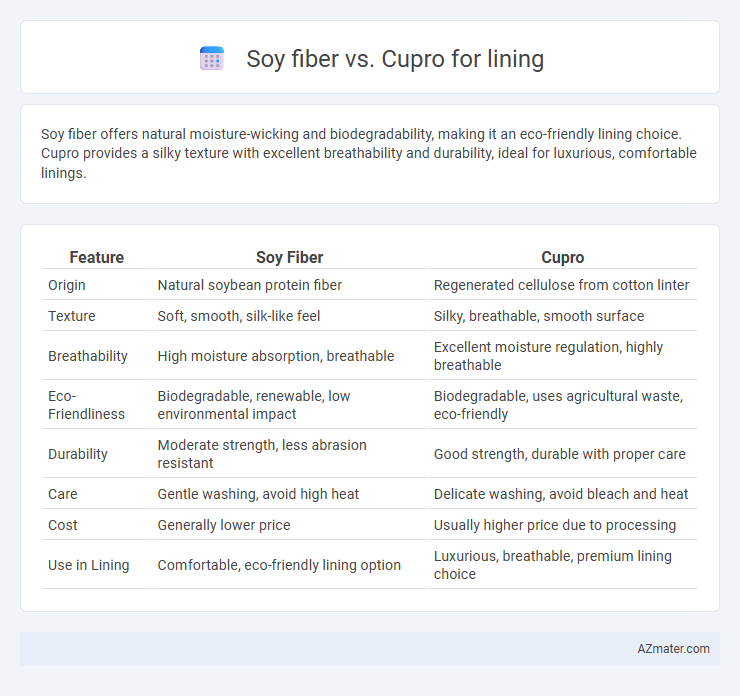Soy fiber offers natural moisture-wicking and biodegradability, making it an eco-friendly lining choice. Cupro provides a silky texture with excellent breathability and durability, ideal for luxurious, comfortable linings.
Table of Comparison
| Feature | Soy Fiber | Cupro |
|---|---|---|
| Origin | Natural soybean protein fiber | Regenerated cellulose from cotton linter |
| Texture | Soft, smooth, silk-like feel | Silky, breathable, smooth surface |
| Breathability | High moisture absorption, breathable | Excellent moisture regulation, highly breathable |
| Eco-Friendliness | Biodegradable, renewable, low environmental impact | Biodegradable, uses agricultural waste, eco-friendly |
| Durability | Moderate strength, less abrasion resistant | Good strength, durable with proper care |
| Care | Gentle washing, avoid high heat | Delicate washing, avoid bleach and heat |
| Cost | Generally lower price | Usually higher price due to processing |
| Use in Lining | Comfortable, eco-friendly lining option | Luxurious, breathable, premium lining choice |
Introduction: The Importance of Lining Fabrics
Lining fabrics play a crucial role in garment construction by enhancing comfort, durability, and overall aesthetics. Soy fiber offers natural breathability and moisture-wicking properties, making it an eco-friendly choice for linings. Cupro, derived from cotton linter, provides a silky smooth texture and excellent drapability, ensuring a luxurious feel against the skin.
What is Soy Fiber?
Soy fiber is a natural, sustainable textile derived from the byproducts of soybean processing, known for its softness, breathability, and moisture-wicking properties. Compared to Cupro, which is a regenerated cellulose fiber made from cotton linter with a silky texture and high absorbency, soy fiber offers a more eco-friendly alternative with biodegradability and nutrient-rich qualities beneficial for skin contact. Both materials excel in comfort as linings but soy fiber's renewable source and hypoallergenic characteristics make it an innovative choice for sustainable fashion.
What is Cupro?
Cupro is a regenerated cellulose fiber made from cotton linter, known for its silk-like texture and breathability, making it an excellent choice for garment linings. Compared to soy fiber, which is derived from soybean protein and offers softness and moisture absorption, cupro provides superior durability and a smooth, non-static feel. This makes cupro particularly favored in high-end linings where comfort, drape, and a luxurious finish are essential.
Production Process: Soy Fiber vs Cupro
Soy fiber is produced from the byproducts of soybean processing, utilizing a bio-based, extruded method that transforms soybean protein into a soft, sustainable textile fiber with minimal chemical input. In contrast, Cupro is a regenerated cellulose fiber derived from cotton linter, involving a complex chemical process where cotton waste is dissolved in cuprammonium solution and then reconstituted into fine, breathable fabric. Both materials emphasize sustainability, but soy fiber's production is more environmentally friendly due to lower chemical usage and reliance on renewable agricultural waste.
Environmental Impact Comparison
Soy fiber, derived from soybean residues, offers a sustainable alternative with low water consumption and biodegradability, making it an eco-friendly choice for lining materials. Cupro, regenerated from cotton waste through a chemical-intensive process, involves significant water and energy usage but benefits from being biodegradable and producing a silk-like texture. Both fibers reduce textile waste, yet soy fiber's lower environmental footprint and renewable source position it as a greener option compared to cupro's chemical processing demands.
Comfort and Breathability
Soy fiber lining offers exceptional moisture-wicking properties and softness, enhancing overall comfort in garments. Cupro lining is lightweight and highly breathable, providing excellent air circulation to keep the wearer cool. Both materials excel in comfort and breathability, with soy fiber delivering superior softness and cupro ensuring optimal ventilation.
Durability and Care Requirements
Soy fiber lining offers moderate durability with natural resilience, making it suitable for garments needing gentle wear resistance, while requiring delicate washing to maintain texture and prevent shrinkage. Cupro lining provides superior durability due to its regenerated cellulose fibers treated for strength, is less prone to wrinkling, and allows for easier care through machine washing or dry cleaning without significant fabric degradation. Both linings enhance breathability and comfort, but Cupro's robust durability and low-maintenance care make it a preferred choice for high-use or formal wear linings.
Allergies and Skin Sensitivity
Soy fiber offers hypoallergenic properties due to its natural protein composition, making it suitable for sensitive skin and reducing the risk of allergic reactions in clothing linings. Cupro, a regenerated cellulose fabric derived from cotton linter, is also gentle and breathable, minimizing irritation but may not be as inherently hypoallergenic as soy fiber. Both fibers provide smooth texture and moisture-wicking benefits, but soy fiber's natural origin gives it a stronger advantage for allergy-prone individuals.
Cost and Availability
Soy fiber linings are generally more cost-effective due to their natural, renewable sources and increasing market availability, making them a budget-friendly choice for sustainable fashion. Cupro, derived from cotton linter cellulose, tends to be pricier and less widely available, as its production involves more complex processing and limited manufacturing facilities. The broader availability of soy fiber enhances its feasibility for mass-market applications, whereas Cupro is preferred in premium or niche segments due to its silky texture and breathability.
Which Lining Fabric is Right for You?
Soy fiber lining offers exceptional breathability and moisture-wicking properties, making it ideal for hot climates and those seeking sustainable, eco-friendly options. Cupro, derived from regenerated cellulose fibers, provides a smooth, silky texture with excellent draping abilities and superior moisture absorption, perfect for luxurious, comfortable garments. Choosing the right lining fabric depends on whether you prioritize natural breathability and sustainability with soy fiber or the silky feel and refined elegance of cupro.

Infographic: Soy fiber vs Cupro for Lining
 azmater.com
azmater.com